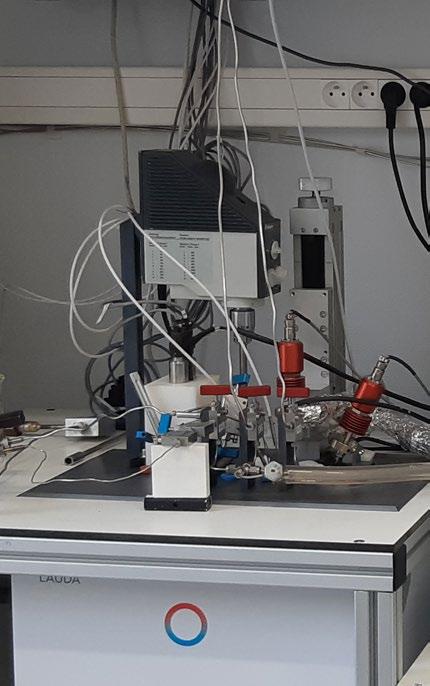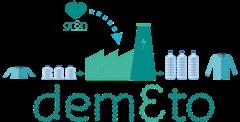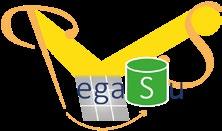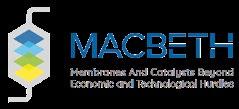
21 minute read
4.3 TECHNOLOGICAL INNOVATION - RESEARCH AND DEVELOPMENT
4.3 TECHNOLOGICAL INNOVATION,
RESEARCH AND DEVELOPMENT
Advertisement
The technological advantage is a key strategic asset for the Group, whose innovation strategy is developed primarily to protect its portfolio of patents and developed technologies.
The Maire Tecnimont Group also leverages its intellectual property assets and technological expertise in order to develop new commercial projects, technology alliances and licensing. INVESTMENT IN RESEARCH AND DEVELOPMENT
Over the last five years, Maire Tecnimont has invested around €37 million in innovation projects, including targeted investments in startups and partnerships, in order to create a portfolio of technologies that responds optimally to the new needs of the ongoing revolution in energy and chemistry.
NRs OF PATENTS OWNED BY THE MAIRE TECNIMONT GROUP 45
131
FAMILY BASED
1,725
EQUIVALENTS
As of the end of 2020, the Maire Tecnimont Group owns a portfolio of more than 1,700 patents, most of which relate to urea and fertilizers.
The Maire Tecnimont Group’s patents and other intellectual property rights covering the products and services it offers, including trademarks, are key assets fundamental to the Group’s success and position.
As innovation is also one of the prime areas of competitive advantage for the Group, we are continuously strengthening our R&D and our portfolio of proprie-
tary innovative technologies in order to boost our position as a technology provider for the refining, power, oil&gas and petrochemical industries. We deliver a number of innovation projects every year and actively cooperate with leading research centers and industrial partners to continuously improve the overall performance of our technologies.
INNOVATION AND R&D
6
INNOVATION CENTERS
81
INNOVATION PROJECTS
~76
PEOPLE INVOLVED IN R&D AS FULL TIME EQUIVALENT
25
PARTNERSHIPS FOR TECHNOLOGICAL DEVELOPMENT
45 The table lists the number of patents, including patent applications. Each patent group has different equivalents (same invention but filed in a different country).
A plaque at the entrance to the Chemical Engineering department of the Polytechnic in Milan recalls that in 1927, Montecatini (from which Tecnimont descends) was one of the first contributors to the purchase of equipment for the new laboratory. This demon-
strates how the Maire Tecnimont Group has always been committed to building a true symbiosis with the university, as a way of interacting with its past, present
and future. Over recent years, the Maire Tecnimont Group has stepped up its collaboration with top Italian and foreign universities, developing research projects and exchanging views and ideas to forge a strong bridge between academia and industry. Maire Tecnimont’s long-standing collaboration with the Polytechnic has been further strengthened with partnerships for research projects, and the funding of a 15-year professorship in Chemical Engineering and Project Management, launched in 2018. We are also heavily engaged in education, specialization and career guidance.
In a scenario in which innovation is becoming a critical factor for success, in 2019 Maire Tecnimont established a synergetic collaboration with the LUISS Guido Carli University by launching a professorship for Open Innovation, the first of its kind in Europe. Important collaborations are also ongoing with La Sapienza University in the field of energy transition technologies and socio-economic studies, and with Campus Bio-Medico, in the context of a master’s degree course in Chemical Engineering for Sustainable Development. Other Italian academic partners include the University of Salerno and the University of Messina.
Internationally, in 2018 the Maire Tecnimont Group began working with BHOS (Baku Higher Oil School), to provide concrete support for their University Master’s Degree course and to supply research facilities. In India, a partnership with the National Institute of Technology in Karnataka has been in place since 2020, as part of our corporate giving programme.
Further collaborations are underway with Eindhoven University of Technology, the École des Mines in Paris, and Tecnalia, a Spanish research center that develops membrane reactors for hydrogen production.
EUROPEAN UNIVERSITY
- TECHNICAL UNIVERSITY OF EINDHOVEN - ÉCOLE DES MINES IN PARIS
ITALIAN UNIVERSITIES
LA SAPIENZA UNIVERSITY OF ROME
UNIVERSITY OF SALERNO
INTERNATIONAL RESEARCH INSTITUTIONS
- NATIONAL INSTITUTE OF TECHNOLOGY IN KARNATAKA, INDIA - BHOS IN BAKU
- TECNALIA IN SPAIN
MILAN POLYTECHNIC
CAMPUS BIO-MEDICO UNIVERSITY OF ROME
LUISS, ROME
UNIVERSITY OF MESSINA
ELECTRIFICATION OF THE STEAM REFORMING PROCESS: A SUSTAINABLE APPROACH TO PRODUCING HYDROGEN WITH REDUCED CO2 EMISSIONS
Today, most hydrogen, known as “grey hydrogen”, is produced through the steam reforming of natural gas. It is estimated that this type of hydrogen, which alone accounts for about 75% of the world’s hydrogen production, is responsible, along with that generated by coal, for almost 3% of global CO2 emissions. This means it is essential to work on developing and imple-
menting different solutions to allow for more
sustainable hydrogen production, while at the same time optimizing the response to the diverse needs of the market.
With a view to decarbonizing the hydrogen production process, “blue hydrogen” is currently one of the technologies being pursued. Unlike grey hydrogen, blue hydrogen involves a
stage through which CO2 is captured for stor-
age or reuse in downstream processes.
In this energy transition scenario, KT - Kinetics Technology and NextChem are working on an innovative proprietary technology for the production of hydrogen, which combines the use of natural gas and electricity from renewable sources using an intelligent solution that acts as a hybrid between blue and green hydrogen. This approach reduces the CO2 generated during the process by up to 45%, thus facilitating its total recovery.
The technology is also highly flexible, and this means it can be easily modularised and therefore adapted to distributed and centralised applications.
THIS APPROACH REDUCES THE CO2
GENERATED DURING THE PROCESS
BY UP TO 45%

RESEARCH AGREEMENT WITH THE ÉCOLE DES MINES IN PARIS: STUDYING THE THERMODYNAMIC BEHAVIOUR OF NATURAL GAS IN THE PRESENCE OF CO2
Natural gas is the fossil fuel with the lowest environmental impact due to its low CO2, NOx and SO2 emissions. It thus plays a key role in the energy transition, and with the growth of liquefied gas (LNG) transport, its potential as a bridge towards a low-carbon economy is even greater.
In 2011, Tecnimont began promoting studies and research to develop a new
natural gas purification technology
that, compared to the technologies currently available on the market, would be both less energy-intensive and more cost-effective, in the context of a more sustainable use of natural gas.
The DCCD™(Dual Column Cryogenic Distillation) technology patented by the Maire Tecnimont Group and experimentally validated during a research project conducted by Tecnimont, is based on an innovative cryogenic distillation process that purifies natural gas, removing CO2 and other impurities to achieve LNG production specifications, which require a residual CO2 content of 50 parts per million (ppm).
The use of this technology for the direct production of LNG requires cryogenic distillation under the stringent purity conditions required for gas liquefaction. The correct design of the distillation columns is based on the reliability of the calculation models used in the process simulation software as compared to the actual thermodynamic properties of natural gas.
Inaccurate or suboptimal forecasting can lead to the oversizing of equipment, which entails a considerable increase in energy expenditure.
In order to refine its knowledge, Tecnimont has signed a Research Agreement with the École des Mines in Paris to study the thermodynamic properties of natural gas with a low CO2 content.
The one-year study was conducted during 2020 and consisted of three separate phases (see table).
Based on the results of the study, Tecnimont’s Research, Innovation and Development Department is working to create new proprietary tools integrated with the process simulators, in order to energetically optimize the DCCD™ technology and its integration with LNG production.
PHASE 1: THEORETICAL STUDY PHASE 2: EXPERIMENTAL STUDY PHASE 3: MODELING STUDY
PERFORMED ACTIVITIES
Bibliographic search of solid-liquid-vapor equilibrium data of gas mixtures Experimental measurements of thermodynamic properties of gases in laboratory Comparison between experimental data and data calculated by process simulators’ models
MAIN OUTCOMES
Lack of data in the desired conditions 89 new experimental points measured Re-definition of models’ parameters
“CO2 TO OLEFINS” RESEARCH PROJECT: CONVERSION OF CO2 INTO HIGH VALUE-ADDED CHEMICALS FOR CARBON VALORIZATION AND EMISSIONS REDUCTION
In order to meet the targets set in the Paris Agreement, it is crucial to adopt strategies to mitigate CO2 emissions from industry and from energy production: these include energy efficiency, the use of renewable resources, and the capture of CO2 emissions.
But once the CO2 has been captured, what can we do with it? The current solution is to store it permanently in underground geological reservoirs, where it is buried without any value being extracted from it. But then, why not reuse that same CO2 as a source of carbon and turn it into chemical compounds?
This is precisely the aim of the collaboration between Tecnimont and the Polytechnic of Milan: to study a way of converting CO2 into high value-added chemicals, with the dual aim of reducing the CO2 emitted and giving it new life.
“CO2 TO OLEFINS” VALUE PROPOSITION
CO2 H2
CO2
CO2 VALORIZATION THROUGH CONVERSION INTO HIGH-VALUE CHEMICALS CO2 EMISSIONS REDUCTION (VS. CONVENTIONAL TECHNOLOGIES) + USE OF NON-FOSSIL H2
NOVEL CATALYTIC MATERIALS AND SYSTEMS FOR CO2 UTILIZATION
CCUS
The specific objective of the “CO2 to Olefins” research project is to develop a new catalyst and a process to convert CO2 into olefins, which are mainly used in the production of plastics such as polyethylene and polypropylene, a sector in which Tecnimont is the market leader.
The three-year project started in November 2019.
During the first year of research, an extensive
study of scientific and patent
literature enabled the most promising and innovative route to be selected from three alternatives for converting CO2 into olefins. The chosen route uses hydrogen from non-fossil sources (such as green hydrogen) as the main CO2 co-reactant. Over the next two years, the new material, will be experimentally developed at the Polytechnic’s laboratories. This will be accompanied by process studies and technical, economic and environmental feasibility analyses conducted by Tecnimont’s Research, Innovation and Development department.

At the end of the three years of research, a decision will be taken as to whether or not to continue with the development of the catalyst and the process, possibly with the construction of a pilot plant to develop a technology capable of reducing emissions by exploiting CO2 as an alternative source of carbon for the production of polymers.
H2O & JOINT DEVELOPMENT
NON-FOSSIL ENERGY ELECTROLYSIS
O2 H2
CO2-DEPLETED GAS CO2 REAGENTS
CO2
RAW OLEFINS BY-PRODUCTS
PRETREATMENTS & COMPRESSION “CO2 TO OLEFINS” CATALYST AND REACTOR
RECYCLE SEPARATION SECTION
OLEFINS
FLUE GASES & OTHER SOURCES CO2 CAPTURE CO2-BASED POLYMERS FOR PLASTIC PRODUCTION
INNOVATION IN THE FERTILIZER SECTOR
Stamicarbon, which is Maire Tecnimont’s innovation and licensing arm, licenses technology for manufacturing urea and also provides follow-up services designed to ensure the best possible operation of a urea plant throughout its working life.
ULTRA-LOW ENERGY DESIGN
Stamicarbon’s novel Ultra-Low Energy Design project is based on a truly radical innovation in energy efficiency, which leads to a reduction of about 40% reduction in the steam consumption of urea plants. This is a significant reduction in energy costs and therefore in operating expenses, and it also substantially reduces the carbon footprint compared to other types of urea plants.
MICROMISTTM VENTURI SCRUBBER
With Micromist Venturi cleaning technology, urea dust emissions of up to 10 mg/Nm3 can be achieved. An additional Wet ElectroStatic Precipitator (WESP) can be integrated into the MMV scrubber, to reduce urea particulate emissions up to 5 mg/Nm3. This washing technology has been combined with Stamicarbon’s fluid bed urea granulation technology, which sets a new standard in urea granulation and emission control.
SUSTAINABLE PRODUCTION OF NITRATE FERTILIZERS
In a consortium led by METDEV, the project development arm of the Maire Tecnimont Group, Stamicarbon is partnering with Siemens and Sowitec (Vestas) to develop a fertilizer plant for the production of green nitrate fertilizers in Kenya. The topic has received a lot of positive responses from the industry in order to make fertilizer production sustainable.
SAFUREX ®
Recycling of high-pressure equipment via a buyback programme in partnership with Sandvik, with whom we have an exclusive collaboration aimed at raising the content of recycled material in our proprietary Safurex® material from 84% to 90%. The pilot project has been successfully completed, and the next opportunities for recycling are now being explored.
SYMBIOSIS BETWEEN STEEL AND FERTILIZERS: BASIC OXYGEN FURNACE (BOF) GAS TO UREA
In a large consortium led by Dutch Research Institute TNO, Stamicarbon, METDEV and NEXTCHEM are participating in the BOF2Urea project. The goal is to apply carbon capture and utilization (CCU) technologies in combination with carbon capture and storage (CCS) technologies based on the off-gases from steel mills, using BF or BOF gas. In this project, Stamicarbon cooperates with Arcelor Mittal.
The objective is to produce ammonia/urea (in this case as AdBlue®), but the process can also be used to produce fertilizers based on recycled carbon. This is a very hot topic, as the decarbonization of the European steel industry is one of the pillars of the proposed “green deal” of the European Union.
FROM ENERGY TO FERTILIZERS
In collaboration with a number of different research institutes, Stamicarbon’s R&D department is developing new advanced technologies for the sustainable production of nitrogen-based fertilizers, using renewable energy and raw materials, and with the lowest possible level of operational expenditure and investment.
SPECIAL FERTILIZERS
With the support of external partners and using the facilities of its pilot plant for fertilizer finishing technologies, Stamicarbon’s strategic R&D department is developing new technologies for the production of sustainable nitrogen-based fertilizers. One technique is to add different nutrients to the fertilizer and to increase the efficient uptake of nutrients while minimizing the footprint of fertilizer production and usage.
RESEARCH PROJECTS
Maire Tecnimont, through its subsidiaries NextChem, KT – Kinetics Technologies and Stamicarbon, participates in numerous research projects either as coordinator or partner. Some of these are EU funded, while others have been nationally funded.



The H2020 project INITIATE (Innovative industrial transformation of the steel and chemical industries of Europe) involves major industrial players from the steel, fertilizer and energy transition industries (Arcelor Mittal, SSAB, Stamicarbon, NextChem), functional material suppliers (Johnson Matthey and Kisuma Chemicals), multidisciplinary research centers (TNO, SWERIM, POLIMI and Radboud University) and experts in the dissemination of circular economy issues (CO2 Value Europe). With the INITIATE circular economy project, the carbon and energy contained in the gases emitted by steelmaking processes become raw material used in the production of urea, which is the basis for the production of fertilizers and other products. The project will demonstrate a reduction of 30% in primary energy intensity, of 95% in the carbon footprint, of 40% in raw material intensity and of 90% in waste production. INITIATE will validate the proposed technologies on a pilot scale in a real industrial environment (TRL7) by producing NH3 from the residual gases of steel production, through three experimental test campaigns lasting six weeks each. Grant agreement No. 958318.
RECYCLING AND EXTRACTING VALUE FROM CO2
The H2020 project DECADE (DistributEd Chemicals And fuels production from CO2 in photoelectrocatalytic Devices) proposes a new photoelectrocatalytic (PEC) approach for the conversion of CO2 to overcome the limitations of current PEC systems and to maximize the effective use of solar energy. Bioethanol and waste CO2 are used to produce a mixture of high value-added products (ethyl acetate and ethyl formate in ethanol), to be used as a green solvent or as a performance-enhancing component for biofuels. The application of this technology on flue gas (containing CO2) from methanol production plants will also be analysed, in order to produce compounds with higher added value, reduce the overall carbon footprint from methanol production, valorise waste CO2 and introduce renewable energy into the production chain. The consortium comprises 14 European partners: European Research Institute of Catalysis A.I.S.B.L. (Coordinator), Interuniversity Consortium for Materials Science and Technology, Fundacio Privada Institut Catala D’Investigacio Química, MAX-PLANCK-Gesellschaft Zur Forderung Der Wissenschaften EV, Asociacion Centro de Investigacion Cooperativa en Biomateriales - CICbiomagune, Forschungszentrum Jülich GMBH, NextChem, HYSYTECH, EKODENGE Muhendislik Mimarlik Danismanlik Ticaret Anonim Sirketi, UNISMART Padova Enterprise, Motor Oil Hellas Diilistiria Korinthou AE, MERIT Consulting House, FILA Industria Chimica, CASALE SA, and 1 international partner: the University of Tokyo. Grant agreement No. 862030.
RECYCLING AND EXTRACTING VALUE FROM CO2 AND IMPLEMENTATION OF SOLAR ENERGY IN PROCESSES
The H2020 project DEMETO (Modular, scalable and high-performance DE-polymerization by MicrowavE TechnolOgy) is aimed at the industrial-scale chemical recycling of PET-based waste by intensifying the alkaline hydrolysis reaction with microwaves. NextChem is involved in the design and construction of a demonstration plant capable of processing 500 kg/day of PET flakes obtained from mechanical recycling, and of producing ultra-pure monomers that can be reintroduced into the production of new “virgin” PET. The consortium running the project consists of 14 European partners from the entire PET value chain (NextChem (Coordinator), 3V Tech, ACTOR Technical University of Denmark, The European Outdoor Group, EuPC, The Fricke and Mallah GmbH, GR3N, H&M Nennes & Mauritz AB, NEOGROUP, RECUPRENDA, PETCIA, SUPSI and Synesis). The project is also being monitored by an Industrial Advisory Board whose members include Coca-Cola, Adidas, Nike, Oviesse, Danone and Unilever, among others, who are committed to researching recycling technologies for their materials of interest. Grant agreement No. 768573.
CHEMICAL RECYCLING OF PLASTICS



The H2020 project PEGASUS (Renewable Power generation by solar Particle Receiver Driven Sulphur Storage Cycle) aims to investigate a new cycle for renewable electricity generation that integrates an innovative solar technology, based on a solid particle centrifugal solar receiver, and a sulphur thermochemical cycle. The passage of sulphur through its various oxidation states allows excess solar thermal energy to be stored in the form of chemical energy through elemental solid sulphur. Unlike conventional storage based on high-temperature fluids such as diathermic oil or molten salts, this particular type of storage is long term, as it is achieved from a compound that is stable at room temperature, and which as such is not subject to degradation through thermal dissipation. Through combustion within a power generation cycle, solid sulphur releases the stored chemical energy as heat, and re-enters the thermochemical cycle. The project is run by a consortium consisting of DLR as coordinator, NextChem, APTL/CERTH, the Karlsruhe Institute of Technology (KIT) and BrightSource (BRS). Grant agreement No. 727540.
IMPLEMENTATION OF SOLAR ENERGY IN PROCESSES
MEWLIFE (MicroalgaE biomass from phototrophic-heterotrophic cultivation using olive oil Wastewater) aims to demonstrate the environmental benefits and economic feasibility of an innovative system of algal biomass cultivation through an integrated phototrophic-heterotrophic cultivation system. The specific objective is the re-use and valorization of waste water used in olive oil production as a source of carbon for microalgae growth. The compounds (starch and carotenoids) accumulated in the algal biomass will be extracted and tested for the production of biopolymers and for use in nutraceutics. The consortium includes 6 partners: NextChem (Coordinator), BIO-P, Labor, High Tech Recycling (HTR), Technosind and Megara Resins. Grant agreement: LIFE17 ENV IT000180 – MEWLIFE.
VALORIZATION OF WASTE STREAMS AND USE OF ALGAL BIOMASS
The H2020 project HIFLEX (HIgh storage density solar power plant for FLEXible energy systems) aims to demonstrate, on an industrial scale, an innovative technology in the field of concentrated solar power, based on a solid particle centrifugal receiver. The use of a solid that can reach temperatures of around 1000 °C as a heat carrier and storage medium enables electricity to be produced by means of highly efficient thermodynamic cycles. The project includes among others NextChem and KT-Kinetics Technology as coordinators, Barilla, DLR, John Cockerill, SUGIMAT, HelioHeat GmbH, Tekfen, Dürmeier and Quantis. The objective is the design, construction and commissioning of a semi-industrial plant within a Barilla production facility. The collected solar energy will be used in the pasta production cycles on the site. This project is the only one of its kind. Grant agreement No. 857768.
IMPLEMENTATION OF SOLAR ENERGY IN PROCESSES
STREAM is funded by the Italian Ministry of Economic Development in the framework of the National Operational Programme on Enterprise and Competitiveness for 20142020. It is focused on developing a technology for wastewater treatment, and offers the opportunity of purifying highly contaminated wastewater, recovering materials of interest and demineralised water for re-use in the production process by exploiting low-value waste energy. The technology underpinning the project involves the use of thermal processes for wastewater concentration, and a refining step for the reuse of water with the aim of achieving a ZLD (zero liquid discharge) system. The prototype, built in Chieti, can be tested on wastewater from various sectors. The project consortium is made up of Quality Engineering Srl, the project coordinator, and NextChem. Unique project code: B18I17000010008.
VALORIZATION OF WASTE STREAMS
The H2020 project BIZEOLCAT (Bifunctional zeolite based catalysts and innovative process for sustainable hydrocarbon transformation) is being run by a consortium of 14 partners: Fundacio EURECAT (Project Coordinator), NextChem, Universitetet I Oslo, Technische Universiteit Eindhoven, Sintef AS, Centre National De La Recherche Scientifique – CNRS, Kemijski Institut, Turkiye Petrol Rafinerileri Anonim Sirketi, Perstorp AB, Strane Innovation SAS, European Research Institute Of Catalysis, A.I.S.B.L., Asociacion Española De Normalizacion, and CEPSA. BIZEOLCAT addresses the need to reduce the carbon footprint of the refining sector by developing innovative catalysts and process models for the conversion of light hydrocarbons (C1, C3 and C4) into light olefins and aromatic compounds. Grant agreement No. 958318.
CHEMICALS PRODUCTION



The INCITE (INnovative Chemoenzymatic InTEgrated processes) H2020 project is fostering the competitiveness of Europe’s green chemistry industry. The project will be demonstrated on the basis of two chemo-enzymatic processes that use enzymes, through the creation of two new demonstration plants in real industrial settings. The first process is catalysed by esterase enzymes of an important precursor in the production of insecticides, while the other process uses lipase enzymes for the solvent-free synthesis of oleochemical esters. Developed by OLEON, the project coordinator, the other project partners are: ENDURA, VLAAMSE INSTELLING VOOR TECHNOLOGISCH ONDERZOEK N.V. (VITO), FRAUNHOFER GESELLSCHAFT ZUR FOERDERUNG DER ANGEWANDTEN FORSCHUNG E.V., BICT, UNIVERSITEIT GENT, ASSOCIATION INDUSTRIES ET AGRO-RESSOURCES and BIO-P, which is in charge of process engineering up to the construction of the demonstration plants. Grant Agreement No. 870023.
PRODUCTION OF NEW BIOCHEMICAL COMPOUNDS
MEMBER (advanced MEMBranes and membrane assisted procEsses for pre- and post-combustion CO2 captuRe) includes a consortium of 17 partners, with Tecnalia as Project Coordinator. The main objective of the MEMBER project is to demonstrate the application of advanced materials and innovative technologies based on membrane separation to pre- and post-combustion CO2 capture processes for power plants and hydrogen production coupled with CO2 capture. Three prototypes will be designed and tested during the course of the project. The project received funding from the European Union’s Horizon 2020 research and innovation programme (Grant Agreement No. 760944).
CO2 CAPTURE
The R&D project PROMECA (PROcess intensification through the development of innovative MEmbranes and CAtalysts) involves a consortium of 6 partners, with the University of Salerno as Project Coordinator. The project’s strategic objective is to make a substantial contribution to empowering the knowledge, skills and competitiveness of European research by implementing a research programme and seconding researchers to academic and industrial partners in Europe; this will make a significant contribution to Europe’s existing trend in innovation. The technological topic of interest is the distributed production of hydrogen from renewable feedstocks, through the innovative technology of catalytic membrane reactors. The project received funding from the European Union through the Marie Skłodowska-Curie and Innovation Staff Exchange (RISE) (Grant Agreement No. 734561).
HYDROGEN PRODUCTION
MACBETH (Membranes And Catalysts Beyond Economic and Technological Hurdles) project aims to demonstrate membrane catalytic reactor technology at an industrial level. The project, coordinated by Evonik, brings together the skills of 24 partners working in selected teams across four lines of technological development who will also engage in simultaneous cross-fertilization activities to identify further ideas for innovation. The project’s large consortium can draw on a wide range of technological expertise in the fields of catalysis, membranes, media, reactors, engineering and modelling, and also includes several end users of the proposed technologies. Sustainability is the key driver of the project, as the new technology aims to significantly reduce GHG emissions by more than 20%, with a simultaneous 20% increase in energy efficiency. The project received funding from the European Union’s Horizon 2020 research and innovation programme (Grant Agreement No. 869896).
CHEMICALS PRODUCTION

LIFE SUGAR (SUstainabIe Glass: Architecture of a furnace heat recovery system including a steam Reformer) project involves a consortium of 5 partners, with Stara Glass as Project Coordinator. The aim of the project is to provide the glass industry with a new technology to reduce energy consumption and CO2 emissions during the melting process, by integrating a steam reforming unit into the plant architecture. The concept will be demonstrated through the design, construction and testing of an innovative steam reformer pilot unit, which will be installed in an industrial environment. The project received funding from the European Union’s Horizon 001314 research and innovation programme (LIFE19 CCM/IT/001314).









